DROPS Air
A medium thick blow yarn made of baby alpaca and merino wool
from:
3.36£
4.19€
Content: 65% Alpaca, 28% Polyamide, 7% Wool
Yarn Group:
C (16 - 19 stitches)
/ 10 ply / aran / worsted
Weight/length: 50 g = approx 150 m
Recommended needle size: 5 mm
Knitting tension: 10 x 10 cm = 17 sts x 22 rows
Care: Hand Wash, max 30°C / Dry Flat
/ Feltable
Superwash: no
Made in: Peru/EU
Raw material origin: Alpaca and wool from South America, polyamide from Germany
This yarn has an Oeko-Tex® certification (certificate number 22.HPE.07484), Standard 100, Class II from the Hohenstein Institute. This means that is has been tested for harmful substances and is considered safe in human-ecological terms. Class II means the yarn is suitable to come in direct contact with the skin to a large extent, such as blouses, shirts, mattresses, etc.
An exciting "blow yarn" made from soft baby alpaca and cozy merino wool - this quality has a unique construction where instead of spinning, the fibers of baby alpaca and merino wool are blown into a tube together. Garments made in this yarn are about 30-35% lighter than those made with conventional spun yarns of the same thickness.
DROPS Air is a light, airy yarn that feels beautiful against the skin, which makes it perfect for sweaters, jackets and accessories, with both texture and cable patterns. Garments made in DROPS Air are totally itch-free, which means everyone can wear them!
Read more about our products' sustainability here
Please be aware that the colours shown may vary from screen to screen in the same way that shades may vary slightly from dye lot to dye lot.
First of all, consider just airing the garment, instead of washing it. If you still desire to wash it, here are some guidelines:
- Hand wash at 30ºC - separately - with wool detergent without enzymes or optical brighteners.
- Don’t let the garment soak. Move the garment gently back and forth, do not rub or squeeze it.
- Rinse the garment until the rinse water is completely clear, making sure the water temperature stays uniform.
- Do a light centrifugation of the garment (about 800rpm), choosing a program that DOES NOT take in water at the start. Or press carefully the water out of the garment with a dry towel. The garment shouldn’t be twisted or rolled.
- To dry the garment, shape it and lay it flat - do not hang - ideally on a warm bathroom floor or on top of a drying rack in a room with good air circulation. Never dry the garment in direct sunlight.
- Don’t tumble dry.
Note: If you are washing a project made with this yarn combined with another, the general guideline is to follow the washing instructions for the most delicate of the yarns you are working with.
Thinking about felting this yarn?
See how this yarn looks before and after felting:


Needles: 5.00 mm
Before: 17 sts x 22 rows
After: 24 sts x 38 rows
Do you have a question about this yarn?
See a list of frequently asked questions (FAQ) about our yarns.
1) What type of fibers make the DROPS yarns?
Yarn can be made from a large number of natural and synthetic fibers. DROPS carries mainly yarns made from wool, cotton, alpaca, linen, mohair and silk. Each fiber type has its own qualities, and they are often mixed to take advantage of the best properties of each one. Coarse yarn has the advantage of being stronger and more durable, and finer fibers offer more softness and comfort. Here a bit about the main fibers we carry:
Alpaca:
Alpaca fleece is the natural fiber harvested from an alpaca, and it is similar in structure to sheep wool fiber. Its softness comes from the small diameter of the fiber, similar to merino wool. It is a soft, durable, luxurious and silky natural fiber. Yarn made from alpaca fibers does not felt or pill easily, and it can be light or heavy in weight, depending on how it is spun. While similar to sheep’s wool, it is warmer, not prickly, and has no lanolin, which makes it hypoallergenic. Alpacas come in 22 natural colors, with more than 300 shades from a true-blue black through browns-black, browns, white, silver and rose-greys.
Mohair:
This fiber comes from the Angora goats, and it's considered a luxury fiber. Mohair yarn is warm as wool, but much lighter in weight; it is durable, dyes well and does not felt easily. Mohair fibers have also a distinctive luster created by the way they reflect light. Despite being a hard fiber, mohair is usually spun into a very fluffy yarn, resulting in airy and lustrous garments.
Wool:
The wool fibers come from the skin of sheep and are relatively coarse fibers. Two striking characteristics of wool are its susceptibility to heat and its felting property, which is caused by the scales on the surface. Depending upon the breed of sheep, the appearance of the wool varies.
Wool from Merino sheep is considered the finest type of wool, having as characteristics that is finely crimped and soft. All the Merino wool in the DROPS yarns has its origins in South America, coming from sheep that have not been subject to Mulesing.
Pure new wool is wool made directly from animal fleece, and not recycled from existing wool garments.
Machine washable wool is wool treated chemically to minimize the outer fuzzy layer of the fibers, and be therefore fitable for machine wash (see Superwash).
Silk:
The silk fiber is a fine continuous fiber produced from the cocoon of a moth caterpillar known as the silkworm. While silkworm is cultivated, the wild or tussah silk is obtained from uncultivated silkworm cocoons. Silk fiber is one of the strongest natural fibers and makes a wonderful knitting yarn. It blends really well with other fibers, especially wool. Silk also dyes beautifully with natural dyes.
Vegetable fibers:
There are several varieties of vegetable fibers, found in the cell walls of plants or vegetables. Of all the varieties, two are recognized as major knitted or textile fibers. They are cotton and linen.
Cotton is the fiber surrounding the seeds in a cotton pod, and it is almost pure cellulose. Cotton is usually white in color but there are green and brown varieties as well. The cotton fiber is most often spun into yarn or thread and used to make a soft, breathable textile that is good for summer clothing and accessories, making a weaker yarn than silk or linen but stronger than wool.
Mercerized cotton is cotton that has been through a mercerization treatment. This treatment gives cotton fabrics and threads a lustrous yarn that is more lustrous than conventional cotton. It is also stronger, takes dye a little more readily, makes the yarn more resistant to mildew and reduces lint. It also may not shrink or lose its shape as much as "regular" cotton.
Linen is a fiber derived from the stalk of the flax plant that is durable and stronger than any other fiber. The linen fiber is relatively soft, straight and lustrous and becomes more beautiful with age. Linen is more comfortable to wear in hot temperatures than cotton, due to the fact that it absorbs moisture better and dries more quickly.
Other materials used in our yarns include synthetic fibers such as acrylic, viscose, polyamide (nylon) and polyester. These fibers are used mostly to give strength to a yarn (like our sock yarn, DROPS Fabel) or a special kind of structure (like our blown yarn, DROPS Air).
The polyamide fibre, commonly known as nylon, is very strong, durable, lightweight, easy to care for (can be machine washed and dried), and elastic, which makes it perfect for blending with other fibres to produce hard-wearing yarns like sock yarn.
Compared to polyester, polyamide is softer and more flexible, but it also absorbs more water and dries slower.
3) What type of information can I find on the DROPS yarn labels?
All DROPS yarn labels include information about fiber content (wool, cotton, etc.), weight in grams and ounces, length in meters and yards, washing instructions and symbols (explained here), color number, dye lot number and yarn group information.
4) What are the DROPS yarn groups?
All DROPS yarns are classified into 6 different thickness groups (A to F). Yarns in a same group have similar knitting tension/gauge, and can therefore be interchanged in patterns; however the length may be different, so when substituting always calculate the amount of meters/yards needed for the pattern to know the amount of yarn you need to get.
5) Can I use a different yarn than the one mentioned in the pattern?
Yes, as long as the yarn can be worked in the same knitting tension/gauge. Always swatch to make sure you get the same number of stitches in width and rows in height as given in the pattern.
Remember that different yarns with different textures, will give the garment different looks. The yardage/length may also be different, so when substituting always calculate the number of yards needed, in order to know the amount of yarn you need.
Read more about how to calculate the amount of an alternative yarn - and how to replace 1 thread of a yarn with 2 or more of another, here.
6) What does it mean when a yarn is “Superwash”?
A superwash wool is a special wool product that has been treated or processed in a way that allows it to be machine washable. Many people are afraid to work with wool because it is so easy to shrink (though some shrink wool on purpose) and superwash wool can allow them to work with great fibers without worry. (Read more here).
7) What does “Oeko-Tex® certified” means?
The Oeko-Tex® Standard 100 was introduced at the beginning of the 1990s as a response to the needs of the general public for textiles which posed no risk to health. The Oeko-Tex® Standard 100 is a globally uniform testing and certification system for textile raw materials, intermediate and end products at all stages of production. The test for harmful substances comprise substances which are prohibited or regulated by law, chemicals which are known to be harmful to health, and parameters which are included as a precautionary measure to safeguard health.
For more info go to www.oeko-tex.com
10) How accurate are the colours on the shade cards online?
When obtaining images for the shade card, we do our best to achieve the highest level of color accuracy. Unfortunately, we cannot guarantee how images will appear on your computer screen. Every monitor displays color differently, some colors might look darker than they really are, and some colors might be more saturated on some screens. If you experience that many of the yarn colors looks different on your screen than the actual color of the skeins, you can adjust the setting on your monitor.
11) What is a micron? What does super fine / extra fine mean?
The fineness of yarn fibers is measured in microns (thousands of millimeters). Super fine alpaca wool is 26-28 microns. Fine merino wool is less than 21.5 microns and extra fine merino is under 19.5 microns. The less microns the softer and more delicate a quality can be, the more microns the more hard wear the quality will be.
The reason why the microns in a yarn’s fibers are important is that the yarn will eventually become something else, and how delicate or coarse a yarn is will determine in part what we use it for. That’s why we recommend the softest yarns (like DROPS Baby Merino) for baby clothing, or why we choose to use a more hard wear yarn like DROPS Snow, for a seating pad or slipper.
12) Why are the colours in my skeins of print yarn different?
The reason why two skeins of a same print yarn look different can be 1) that both skeins are part of different dye lots; 2) that the skeins have been dyed using a technique called "magic print" (the one used for example in DROPS Delight), which provides unique patterns and smooth colour transitions to each skein, meaning also that within one dye lot, lighter or darker varieties might appear. This is no fault or defect, but part of the yarn's character.
13) My store doesn’t have the colour I want, what can I do?
If your DROPS store doesn’t have the yarn colour you want, try contacting a DROPS Super Store (the ones with the golden badges) - they will make sure to get a hold of the colour even if they don’t have it in stock themselves. See a list of all DROPS stores here.
14) Where can I find a specific dye lot of a colour?
Always try contacting your DROPS store first. If they do not have the dye lot you want we recommend you to ask other knitters and crocheters in the DROPS Workshop in Facebook or Ravelry, which may have the dye lot in their stash and might be willing to part from it.
Yarn sheds because there's not enough twist to hold all of the fibers together. All yarns have excess fibers (from production) that might come off as lint or shedding, in varied degrees that depend on how the yarn is spun. Brushed yarns ("hairier" yarns) like DROPS Melody, have more of these loose fibers than other yarns, and therefore shed more. Shedding also depends on what is worn under or over the garment, and whether this pulls at the yarn fibers. It’s therefore not possible to guarantee that there will be no shedding.
Below are some tips on how to get the best result when working with hairier yarns:
- When the garment is finished (before you wash it) shake it vigorously so the looser hairs come off. NOTE: do NOT use a lint roller, brush or any method that pulls at the yarn.
- Place the garment in a plastic bag and put it in your freezer - the temperature will cause the fibers to become less attached to each other, and excess fibers will come off easier. Leave in the freezer for a few hours before taking it out and shaking it again.
- Wash the garment according to the instructions on the yarn label. Garments worked with hairier yarns usually need to be shaken once dry after washing, so that the hairs rise and any excess fibers can come off.
Pilling is a natural process that happens to even the most exclusive of fibers. It's a natural sign of wear and tear that is hard to avoid, and that is most visible in high friction areas of your garment like a sweater's arms and cuffs.
You can make your garment look as new by removing the pilling, using a fabric comb or a pill/lint remover.
How can I replace this yarn?
If you are looking to replace this yarn with another DROPS yarn, you can use another yarn within the same yarn group, or try our yarn converter!
Comments / Questions (482)
![]() Gail Coulson wrote:
Gail Coulson wrote:
Does this yarn pill a lot? I've never used Drops, but I've heard this about another of your yarns.
23.04.2025 - 22:11DROPS Design answered:
Dear Gail, Pilling is a natural process that happens to even the most exclusive of fibers. It's a natural sign of wear and tear that is hard to avoid, and that is most visible in high friction areas of your garment like a sweater's arms and cuffs. You can make your garment look as new by removing the pilling, using a fabric comb or a pill/lint remover. Happy knitting!
26.04.2025 kl. 19:56
![]() Madde wrote:
Madde wrote:
Hej jag har virkat i både Drops Air och Drops Paris som ska vara exakt samma storlek och har använt samma virknål. Varför blir drops paris så mycket större när jag virkar exakt samma sak som jag virkat av drops air? även stolparna blir högre? Är drops air mer som storlek B egentligen för att det är så pass luftigt och mjukt? Borde inte samma storlek på garn och samma stolek på virknål ge samma resultat, finns det något annat som påverkar?
14.03.2025 - 12:39DROPS Design answered:
Hei Madde. Heklenålen i oppskriften er kun veiledene, man må bruke den heklenål str. som gir deg den oppgitt heklefastheten i oppskriften. Så om du bruker en hekle str. i Paris, er det godt mulig at du må bruke en annen str. i Air for å få den heklefastheten det står i oppskriften. mvh DROPS Design
24.03.2025 kl. 07:49
![]() Marte wrote:
Marte wrote:
Jeg kjøpte fargen 56 peppermynte, og fargen ser totalt annerledes ut på bildet enn i virkeligheten. Det er to helt forskjellige farger. I virkeligheten er den grå/blå og ligner mer på 48.. Skikkelig skuffet!
13.02.2025 - 11:35DROPS Design answered:
Hej Marte, nej det stemmer ikke... tag kontakt med butikken hvor du har købt garnet, der må være sket en misforståelse...
20.02.2025 kl. 13:36
![]() Monica Grafström Hinckley wrote:
Monica Grafström Hinckley wrote:
Hi, The navy blue 09 looks to be more purple than navy blue. Is that correct? Or is that just how it looks online.
04.02.2025 - 20:48DROPS Design answered:
Dear Monica, as stated in the "About this yarn" tab: "Please be aware that the colours shown may vary from screen to screen in the same way that shades may vary slightly from dye lot to dye lot." So it may look more purple in that photo or in your screen, but that doesn't mean that it will be exactly that colour. You can check the color in this pattern, which uses colour 09 and you can also see some examples in the the #dropsfan gallery for the pattern, which will show you the same colour under different lighting. Happy knitting!
23.02.2025 kl. 20:02
![]() Avalon wrote:
Avalon wrote:
Kan dette garnet brukes til babyteppe? Jeg har strikket et babyteppe halvveis men la nå merke til at det ikke står trygt for 0-3 år sånn som det står på noen andre drops garn.
09.01.2025 - 19:12DROPS Design answered:
Hei Avalon. DROPS Air er et blow yarn (ullfibrene er blåst inn i en strømpe), slik at fibrene er mer "løse" enn et spunnet garn. Ved bruk kan de løse fibrene lage litt nupper / små ulldotter, men et baby teppe ligger for det mest i ro, og det skapes ingen nupper. Men kanskje vær litt obs på at babyen ikke sutter på teppet. mvh DROPS Design
13.01.2025 kl. 07:51
![]() Lina Hansson wrote:
Lina Hansson wrote:
Hej, Jag har tänkt sticka med air och har valt färgerna natur och crimsonröd. Jag funderar på om det finns risk att den röda färgar av sig vid blockning eller tvätt? Behöver jag tvätta det någon gång innan jag stickar mitt plagg? Eller kommer det gå fint att ha dessa färger ihop utan oro för att det ska färga av sig så länge jag följer tvättråden?
08.01.2025 - 13:44DROPS Design answered:
Hei Lina. Så lenge du følger vaskeanvisningen skal det gå fint. Men for sikkerhetsskyld, ta 1 meter eller 2 av den røde fargen, legg det i et glass med lunket vann og se etter en liten stund om vannet har blitt rødt. Men husk: För det första bör du alltid överväga om plagget bara behöver vädras istället för att tvättas. mvh DROPS Design
13.01.2025 kl. 07:35
![]() Inger Fransson wrote:
Inger Fransson wrote:
Har stickat en kofta i drops air gammalrosa. Tyvärr blir den väldigt nopprig. Synd då man lagt ner arbete på att sticka .
03.01.2025 - 16:02
![]() Judith Rostin wrote:
Judith Rostin wrote:
Hallo, ich hätte eine Frage. Ich habe aus der Drops Air für eine Kundin einen Pullunder gestrickt. Sie schreibt mir nun, dass der Pullunder nach 1x Tragen total ausgeleiert ist (lang und breit geworden). Ich kann mir das überhaupt nicht vorstellen, ich habe schon sehr viel mit der Air gestrickt und hatte noch nie Probleme. Haben Sie vllt einen Rat für mich? Vielen lieben Dank
11.12.2024 - 17:18DROPS Design answered:
Liebe Frau Rostin, wenn sie die Pflegehinweise richtig folgen, dann sollte sie kein Problem beim Waschen haben, aber gerne können Sie Ihr DROPS Händler mal direkt fragen, so schreiben sie uns direkt die Reklamation. Danke für Ihr Verständnis.
12.12.2024 kl. 10:25
![]() Sara wrote:
Sara wrote:
Krymper garnet når man håndvasker det ved 30 grader?
09.12.2024 - 19:25DROPS Design answered:
Hei Sara. Følger du vaskeanvisningen til garnet skal det ikke krympe. Men les gjerne mer om garnet under: Garn&Pinner / DROPS Air / Mer info / Vaskeanvisning / Les mer om vasking av garn. mvh DROPS Design
16.12.2024 kl. 07:37
![]() Isabelel wrote:
Isabelel wrote:
Bonjour, J'ai défait un pull tricoté avec la laine Drop Air, mais le fil semble avoir perdu son volume initial. Auriez-vous une astuce pour lui redonner son gonflant ? Merci beaucoup
09.12.2024 - 09:48
![]() Lelletta wrote:
Lelletta wrote:
Buonasera! Sono in un gruppo fb garn studio per aiutarci. Volevo comprare air, ma i tanti commenti negativi che ho letto nel gruppo mi hanno fatto cambiare idea! Anche qui, tra i commenti ne ho letti alcuni, nemmeno tanto recenti. Quindi è un problema che non è ancora risolto. Non fate nulla per migliorare, ma così perderete i clienti. Io sono una "veterana" di queste lane, ma se è così, cambierò fornitore! Peccato!
07.12.2024 - 14:48
![]() Maryam wrote:
Maryam wrote:
Bonjour j ai la peau tres sensible. Laquelle de vos laine ne grattent pas du tout? merci
05.12.2024 - 13:48DROPS Design answered:
Bonjour Maryam, tout dépend de votre propre sensibilité, n'hésitez pas à contacter votre magasin DROPS qui pourra vous conseiller, même par mail ou téléphone. Bon tricot!
06.12.2024 kl. 08:20
![]() Noomi Hansen wrote:
Noomi Hansen wrote:
Jeg vil gerne købe DROPS AIR 300 g farve 31 (sort) og 125 g Drops KID-Silk farve 02, men jeg kan ganske enkelt ikke finde ud af, hvor og hvordan jeg skal bestille det. Håber på Jeres hjælp. Med venlig hilsen Noomi Hansen Rønne
20.11.2024 - 09:42DROPS Design answered:
Hei Noomi. På vår hjemmeside kan du klikke på FIND EN BUTIK! Deretter klikker du på den butikken du ønsker å kjøpe garn fra. Butikkene har forskjellige nettsider, så det kan se forskjellig ut. Om du ønsker å bestille direkte fra et DROPS nr. /plagg klikker du på Bestill knappen under bilde av modellen /plagget. Du får da beskjed fra hvilken butikke du bestiller ifra før du klikker Bestill og kommer til butikkens nettside. mvh DROPS Design
25.11.2024 kl. 08:14
![]() France BAIN wrote:
France BAIN wrote:
Bonsoir! Je suis perdue malgré votre aide trop générale pour tricoter les manches en aiguilles droites. Pourriez vous pour le modèle 232/14 taille SMALLNme dire : 1 =côtes en couleur 'blé' comme ,le corps ou toute la manche en 'rose sable'??? 2 = ligne 5 y a t-il inversion des chiffres : quand la manche mesure 13 ou 22 cm ,,????,, TAILLE SMALL 3 = expliquez moi avec détails et précisions les augmentations car je n'y comprends plus rien.... MERCI ET CORDIALEMENT
10.11.2024 - 19:29DROPS Design answered:
Bonjour Mme Bain, les manches se tricotent entièrement en rose sable, mais le dos et les devants se tricotent d'abord en blé, puis à 20 cm, on tricote 4 rangs en rose, 4 rangs en blé et on termine en rose sable. La bordure des devants et le col se tricotent aussi en rose sable. Bon tricot!
11.11.2024 kl. 10:45
![]() France BAIN wrote:
France BAIN wrote:
Bonjour! Je tricote modele 232/14 gilet manches courtes avec des aiguilles droites et pourriez vous me donner les explications pour les manches en aiguilles droite? (explication en aiguille ronde seulement hélas) Cordialement et merci
25.10.2024 - 11:04DROPS Design answered:
Bonjour Mme Bain, cette leçon vous aidera à faire les ajustements nécessaires pour tricoter les manches en allers et retours (et pas en rond). Bon tricot!
25.10.2024 kl. 14:12
![]() Clarita wrote:
Clarita wrote:
I love this yarn
21.08.2024 - 08:58
![]() Nancy wrote:
Nancy wrote:
Hello, I would like to follow a pattern which uses DROPS Air, but I am interested in using 2 strands of lighter-weight yarn for a fuzzier look with blended colours. Would DROPS Alpaca and DROPS Kid Silk together be appropriate?
08.08.2024 - 22:49DROPS Design answered:
Dear Nancy, sure, just make sure your tension is correct and/or adjust needle size if needed (just as usual) - see some colors examples here, find there Alpaca + Kid-Silk. Happy knitting!
09.08.2024 kl. 08:02
![]() Chloe Pitts wrote:
Chloe Pitts wrote:
Hi, can you please tell me why this yarn is not Oeko-Tex certified?
29.06.2024 - 14:25
![]() Maren Lovise Erichsen wrote:
Maren Lovise Erichsen wrote:
For noen år siden kjøpte jeg drops air i farge 18 - lys isblå uni. Nå finner jeg ikke den igjen. Er det samme som farge 18 - morgentåke?
26.04.2024 - 23:37DROPS Design answered:
Hei Maren Lovise. Ja, det er det. Fargenavn kan forandres i løpet av årene, men farge nr skal alltid være det samme. mvh DROPS Design
29.04.2024 kl. 06:51
![]() Monnin wrote:
Monnin wrote:
Bonjour, j'ai tricoté un gilet avec la laine drops air il est superbe mais il a tendance à boulocher; comment y remédier ?
17.04.2024 - 13:44DROPS Design answered:
Bonjour Mme Monnin, Les bouloches sont un processus naturel qui arrive aux fibres les plus exclusives. C'est un signe d'usure naturel qu'il est difficile d'éviter, et il est davantage visible à des endroits où il y a frottement comme par exemple les manches et les poignets d'un vêtement. Vous pouvez redonner un aspect neuf à votre vêtement en retirant les bouloches avec un peigne ou un ustensile adapté.
17.04.2024 kl. 15:35
![]() CLEMENT Martine wrote:
CLEMENT Martine wrote:
Bonjour, Je viens de réaliser un pull avec cette laine Drops Air, je le trouve très beau sauf un peu près du corps, je le préfèrerai un peu plus large. Est ce possible de le détricoter sans abimer la laine ? Cette laine a-t-elle tendance à se détendre un peu au lavage ? Dans ce dernier cas, je le laisserai tel quel ? Merci à vous pour votre réponse.
10.03.2024 - 21:05DROPS Design answered:
Bonjour Martine, vous pouver facilement detricoter cette laine sans abimer sa qualite. Air se détendre un peu au lavage, mais pas beaucoup. Le vetement revient a ses mesures apres sechage, Bon travail!
12.04.2024 kl. 08:08
![]() Sharon wrote:
Sharon wrote:
Is Drops Air suitable for new born babies clothes?
06.03.2024 - 17:30DROPS Design answered:
Dear Sharon, alpaca yarns with "small hairs" such as DROPS Air aren't usually recommended for newborn babies. It's better for slightly older children, from 1 year old on more or less. Happy knitting!
10.03.2024 kl. 19:36
![]() Donna Bsf wrote:
Donna Bsf wrote:
Wool feels and looks beautiful but there are several cuts in the thread of some balls which require tying. Is this normal? Annoying when thread disappears in middle of row when plenty of wool left in ball.
06.03.2024 - 11:17DROPS Design answered:
Dear Mrs Bsf, if you feel there is something wrong with the yarn please contact your DROPS store and give them all possible informations and add pictures. They will then fowards us your complaint. Thanks for your help and comprehension.
15.04.2024 kl. 08:50
![]() HELLE SVARE wrote:
HELLE SVARE wrote:
Hej Jeg vil spørge om der findes en opskrift på et Sofia Scarf i DROPS AIR garn på pinde 5..... det er i såååå mange flotte farver - så det skal prøves :-) mvh Helle
12.02.2024 - 11:32DROPS Design answered:
Hei Helle. Ta en titt på DROPS oppskriftene 242-33, 242-45, 242-12, 238-15 og 234-79. Har kan du bruke DROPS Air (1 tråd). mvh DROPS Design
15.02.2024 kl. 08:27






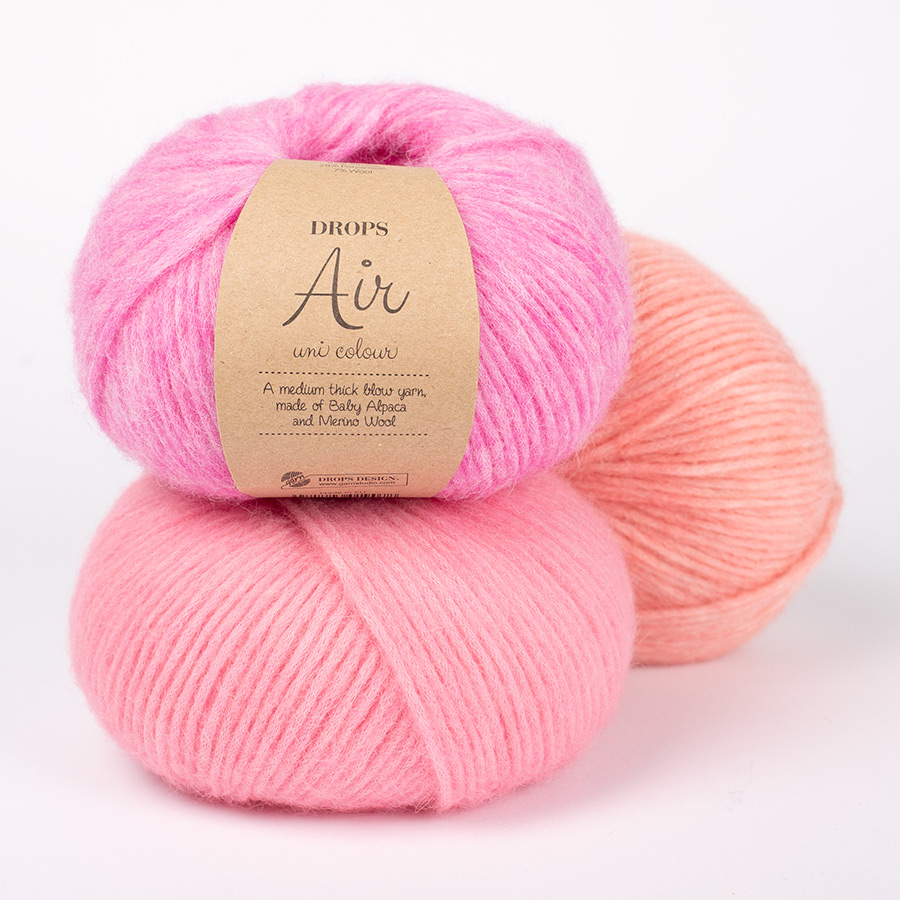
























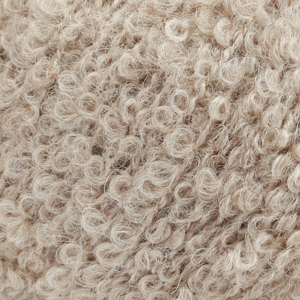















































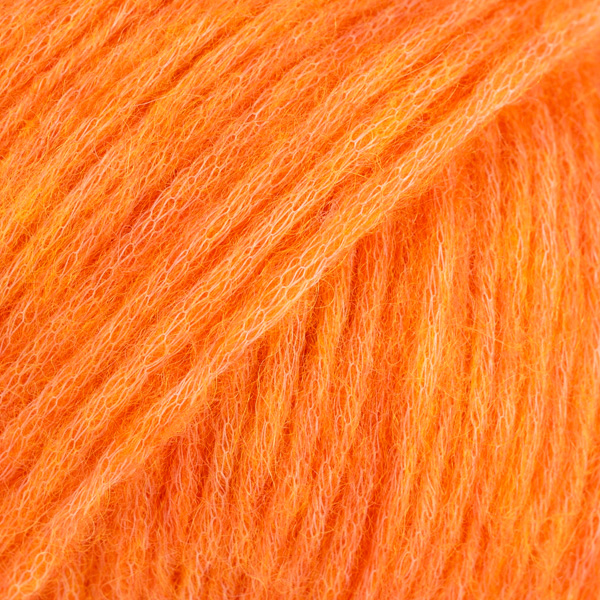



















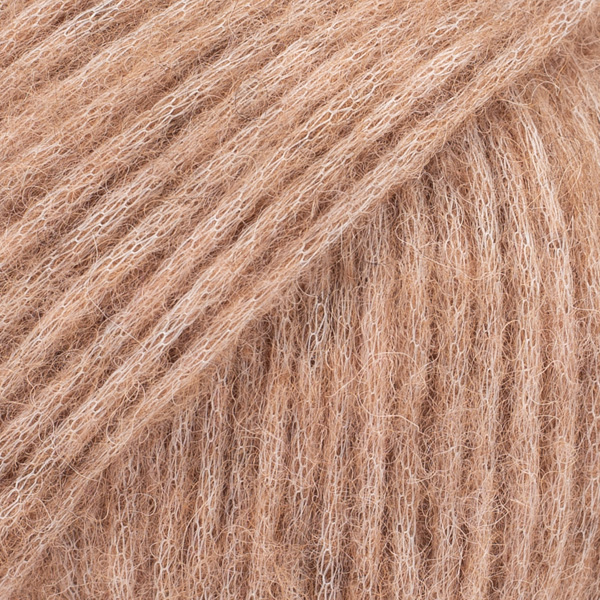












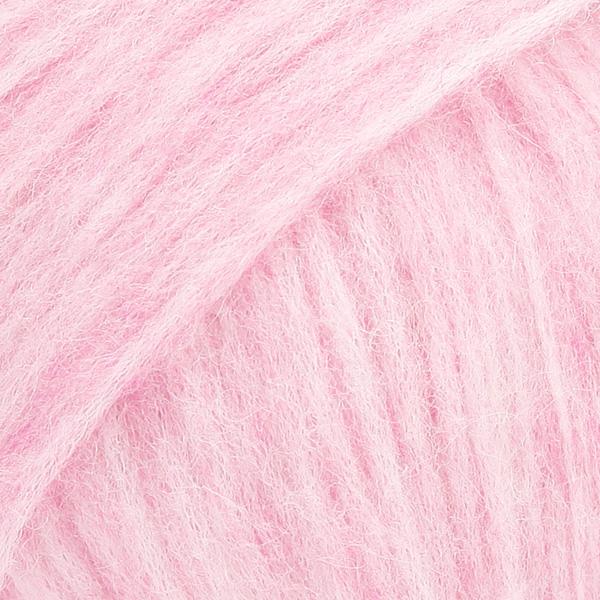



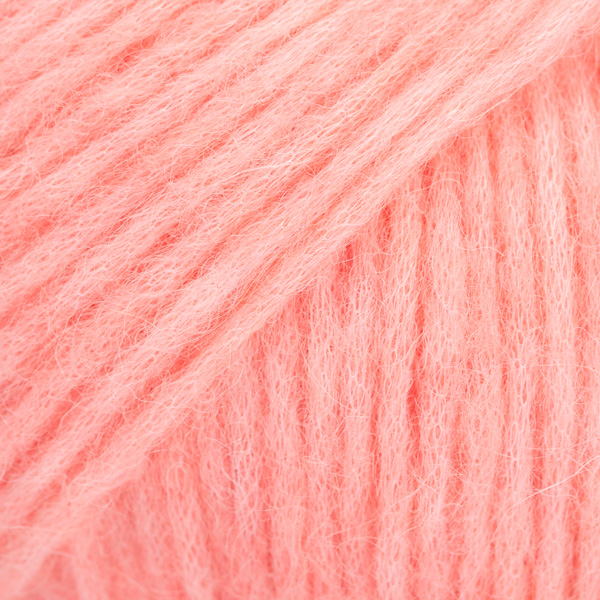







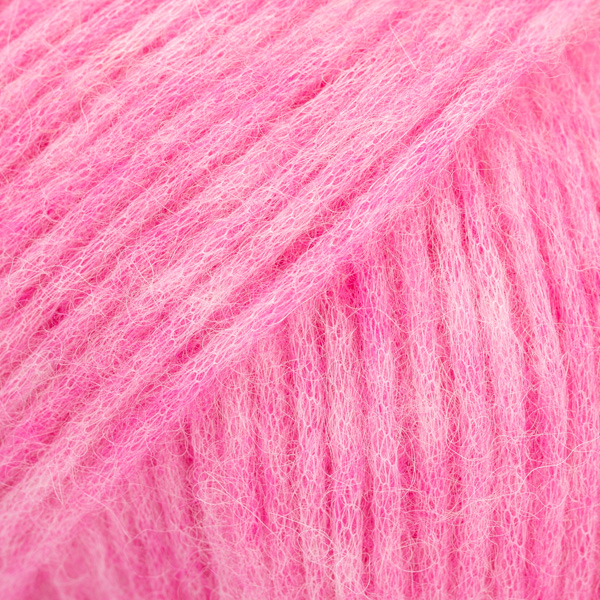
























































































































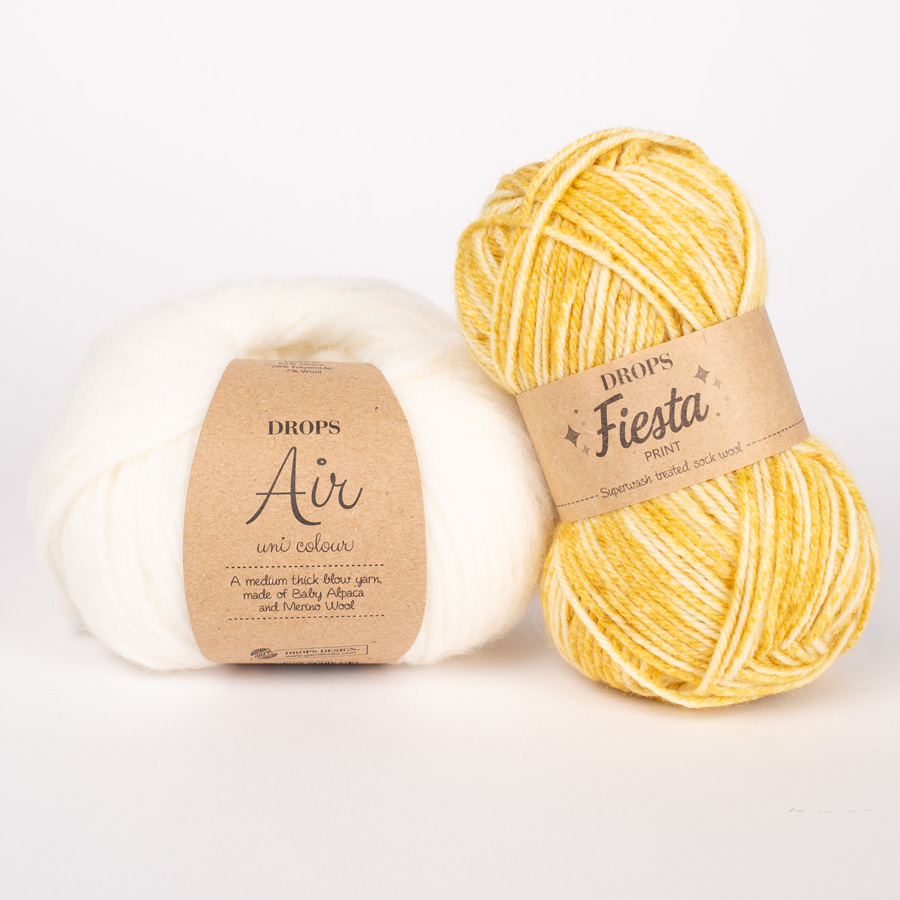











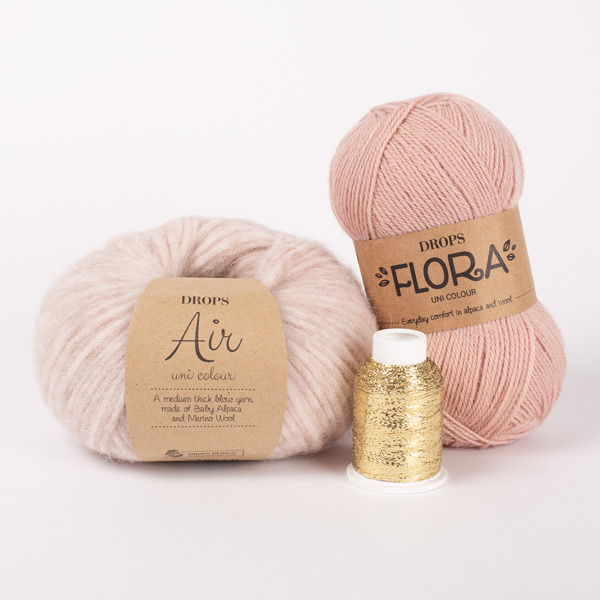



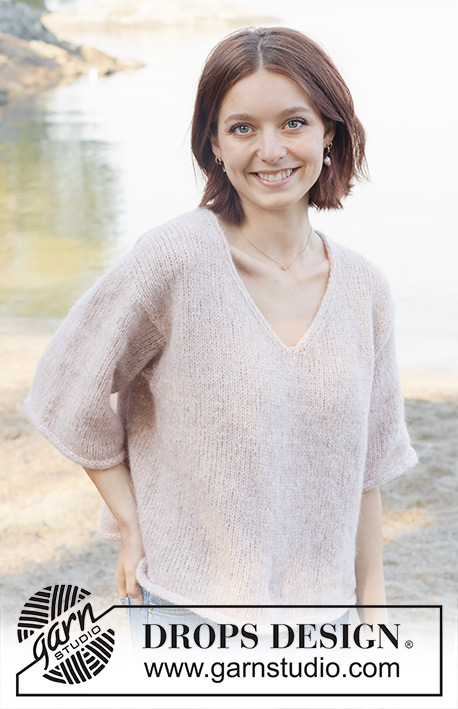

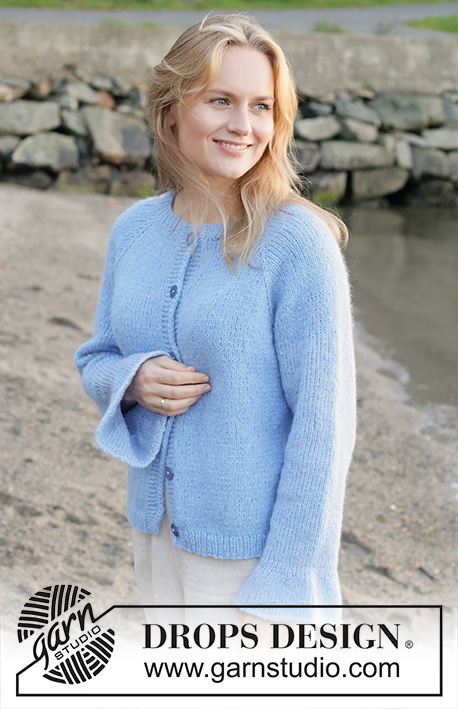










Hallo, vh habe aus Drops Air den Pullover "Winter colours" gestrickt. Er passt super, das Garn liessich leicht verstricken und fühlt sich auch wunderbar auf der Haut an. Ich habe ihn noch nicht einmal gewaschen, nur gelüftet, trotzdem bildet er nach ca. 10x tragen unzählige Knötchen. Und zwar über die ganze Fläche, nicht nur an den besonders reineintensiven stellen. Der Pullover sieht mittlerweile aus als wäre er schon uralt (vor zwei Monaten fertig gestellt und das erste Mal getragen).
10.02.2025 - 21:09